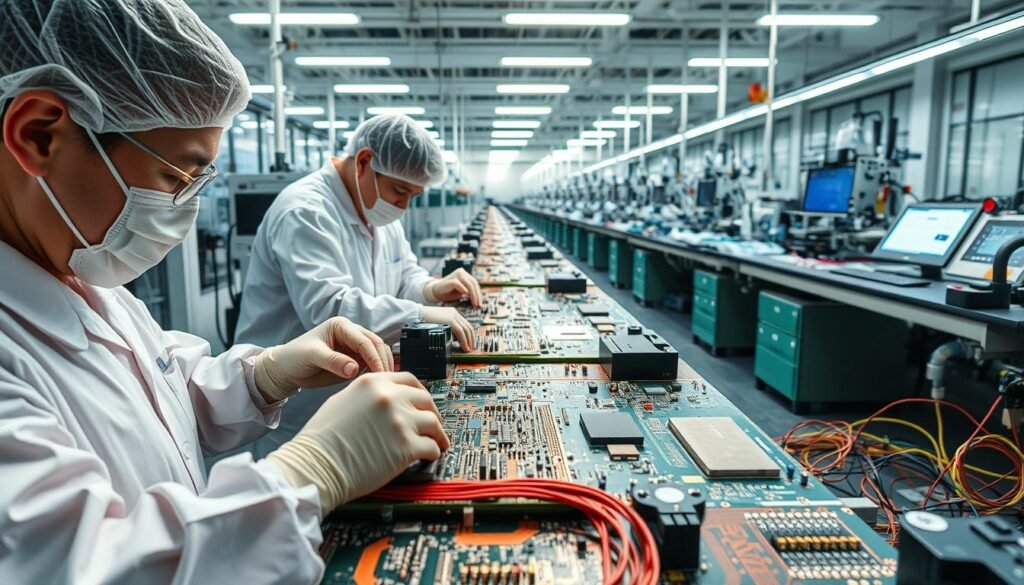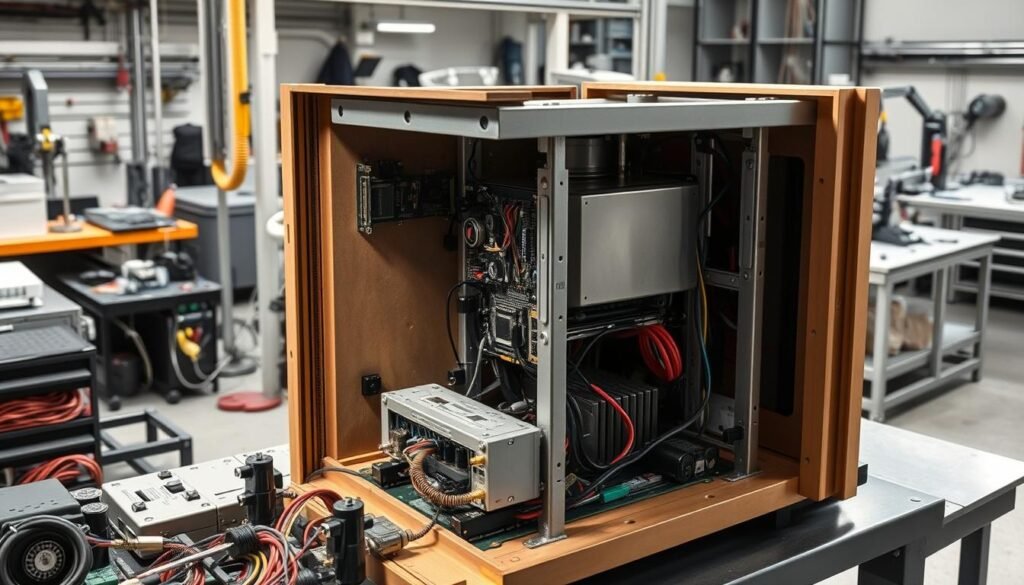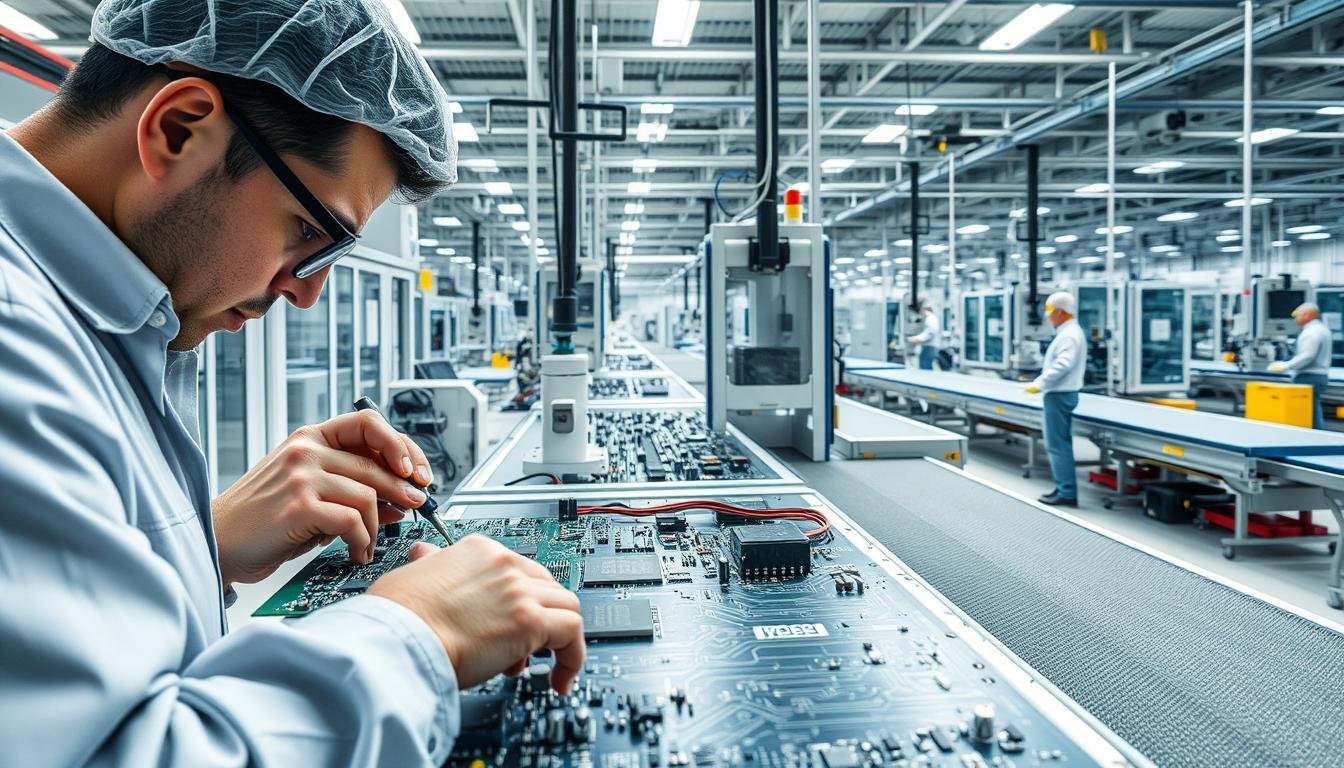What separates a functional circuit board from a market-ready electronic device? The answer lies in mastering the final 15% of electronics manufacturing – where components evolve into complete systems ready for real-world use.
We understand that creating modern devices requires more than populating PCBs with chips and resistors. True success emerges when every element – from circuit boards to enclosures – works harmoniously. This integration defines comprehensive box build services, transforming individual parts into polished solutions.
Our approach blends precision engineering with practical design insights. Whether developing medical equipment or consumer gadgets, we ensure each system meets rigorous performance standards. The process demands expertise in thermal management, component spacing, and user-centric design – factors often overlooked in basic PCB assembly.
Key Takeaways
- Final system integration determines product reliability and user experience
- Advanced manufacturing combines technical precision with functional design
- Custom enclosures protect electronics while enabling intuitive interaction
- Scalable solutions support projects from prototypes to mass production
- Cross-industry expertise ensures compliance with sector-specific standards
While many focus solely on board-level assembly, we prioritize the complete journey. This philosophy helps clients avoid costly redesigns and delayed launches. By addressing mechanical, electrical, and environmental factors early, we create products that excel beyond laboratory testing.
Introduction to Box Build Assembly
Modern electronic devices demand more than perfectly soldered circuit boards. They require seamless integration of technical elements into cohesive solutions that withstand real-world use. This is where true manufacturing expertise shines.
Defining Modern System Integration
We view complete product creation as a three-dimensional puzzle. Electronic components merge with mechanical parts and protective casings to form functional devices. As one industry expert notes:
“The magic happens when technical specs meet human interaction design.”
Our process ensures every wire, fastener, and interface aligns perfectly. Thermal pads sit precisely where heat builds. Buttons fall naturally under fingertips. This precision transforms individual parts into reliable systems.
Cross-Industry Implementation
From aircraft cockpit panels to portable glucose monitors, tailored solutions matter. Aerospace applications demand vibration-resistant enclosures. Medical tools require sterilizable materials. Consumer tech prioritizes sleek profiles.
We’ve engineered weatherproof control units for agricultural machinery and ultra-compact payment terminals for retail. Each project confirms one truth: successful integration bridges technical performance with user needs. The right approach prevents costly redesigns and accelerates market entry.
The Role of PCB Assembly in Electronics Manufacturing

Electronics manufacturing hinges on a crucial step that bridges design and functionality. At its core lies PCB assembly – the process where electronic components become permanently bonded to circuit boards. This stage transforms bare substrates into operational foundations for all modern devices.
Distinguishing PCB Assembly from Box Build Assembly
We approach PCB assembly as component-level craftsmanship. Surface Mount Technology (SMT) machines place microscopic resistors and capacitors with micron precision, while through-hole soldering secures larger components. The result? Functional circuit boards ready for integration.
This differs fundamentally from system-level manufacturing. Where PCB assembly focuses on individual boards, complete product creation requires combining multiple subsystems. Think of it like building engines versus assembling entire vehicles.
Integrating Electronic Components for a Complete System
Our technicians treat populated PCBs as vital organs needing protective casings and connective tissue. Wiring harnesses become nervous systems. Enclosures act as skeletal structures. Thermal interface materials serve as circulatory networks.
This integration demands more than technical skill – it requires understanding how electronic products behave in real environments. We test assembled systems under stress conditions, ensuring circuits maintain performance when encased and interconnected.
Box Build Assembly: From PCB to Finished Product
The final stages of manufacturing turn technical components into user-ready solutions. Our methodology combines precision execution with strategic oversight, ensuring every product meets both technical specifications and end-user expectations.
Step-by-Step Overview of the Process
We begin by securely mounting populated circuit boards into custom housings. Our technicians use specialized fixtures to align connectors with input/output ports, creating reliable pathways for power and data transmission. Proper spacing between components prevents thermal interference while maximizing accessibility for future maintenance.
Cable management follows, with wire harnesses routed through pre-designed channels. This minimizes electromagnetic interference and reduces wear risks. We employ strain-relief techniques at connection points, particularly for devices exposed to vibration or frequent movement.
Best Practices for Ensuring Quality and Functionality
Three core principles guide our work:
- Validation at Every Stage: Each sub-assembly undergoes functional testing before integration
- Documentation-Driven Execution: Real-time updates to digital work instructions maintain process consistency
- Environmental Simulation: Completed units face stress tests mimicking real-world operating conditions
For comprehensive manufacturing solutions, we combine automated optical inspection with manual verification. This dual approach catches both microscopic soldering flaws and macroscopic fitment issues. Final configuration includes firmware installation and calibration, ensuring products ship ready for immediate deployment.
Key Stages and Best Practices in Box Build Assembly

Transforming electronic prototypes into market-ready devices requires meticulous planning at every production phase. Our methodology combines technical precision with operational efficiency, ensuring each product meets both engineering specifications and user expectations.
Design and Engineering Considerations
We initiate projects with collaborative design reviews that balance functionality with manufacturability. Our engineers employ Design for Manufacturing (DFM) principles to eliminate potential production bottlenecks while maintaining quality standards. This proactive approach reduces material waste by up to 22% compared to traditional methods, as detailed in our box build process documentation.
Component Integration and Enclosure Assembly
Multi-vendor component integration demands rigorous validation protocols. We implement:
- Automated optical inspection for microscopic defect detection
- Cross-compatibility testing across power supplies and connectors
- Vibration-resistant mounting solutions for sensitive electronics
Our enclosure designs combine aluminum alloys with polymer composites, achieving optimal thermal management without compromising structural integrity. Custom-machined housings undergo stress analysis to ensure durability in harsh environments.
Testing, Quality Control, and Final Packaging
Three-tier verification processes guarantee product reliability:
- Component-level functionality checks
- System integration stress testing
- Environmental simulation (temperature cycling, humidity exposure)
Final packaging solutions incorporate anti-static materials and custom foam inserts, protecting devices during transit while maintaining assembly design best practices. Each shipment includes detailed documentation for seamless regulatory compliance.
Challenges, Solutions, and Industry Trends in Box Build Assembly
Creating reliable electronic systems requires overcoming three critical hurdles: component complexity, environmental demands, and evolving regulations. Our experience shows these challenges become opportunities when addressed through strategic engineering and adaptive processes.
Managing Complex Wiring and Heat Dissipation
Modern devices pack more functionality into smaller spaces. We tackle tangled wiring issues through color-coded harnesses and 3D routing simulations. Our team uses flexible circuit boards where possible, reducing cable counts by up to 40% in compact designs.
Thermal management solutions combine computational fluid dynamics with material science. Aluminum heat sinks work alongside phase-change materials in high-power applications. This dual approach maintains safe operating temperatures without adding bulk.
| Industry | Key Requirement | Our Solution |
|---|---|---|
| Aerospace | Vibration resistance | Shock-mounted components |
| Medical | Sterilization compliance | IP68-rated enclosures |
| Consumer Tech | Cost efficiency | Modular designs |
Adapting to Regulatory and Quality Standards
California’s tech ecosystem drives innovation in manufacturing standards. We implement ISO 13485 for medical devices and AS9100D for aerospace projects. Our documentation system auto-updates when regulations change, ensuring continuous compliance.
Cross-functional teams validate every production run. Electrical safety tests meet UL guidelines, while environmental chambers simulate decade-long wear in 72 hours. This proactive approach prevents 92% of potential field failures during prototyping.
Emerging trends like modular box build architectures allow cost-effective customization. By combining California’s engineering expertise with global supply chains, we deliver solutions balancing performance, durability, and market demands.
Conclusion
Turning technical blueprints into real-world solutions requires more than component assembly. The true value emerges when functional circuit boards evolve into complete systems through expert integration. This final phase adds critical user-facing elements – intuitive interfaces, durable enclosures, and reliable connectivity – that transform prototypes into polished electronic products.
Specialized teams streamline this transition by combining engineering precision with practical design insights. From medical equipment to automotive controls, we ensure every comprehensive guide to box build strategies meets industry-specific demands. Our methodology bridges technical requirements with manufacturing realities, reducing time-to-market by 34% compared to in-house efforts.
Three factors define successful outcomes:
1. Scalable solutions: Seamlessly transition from prototyping to full-scale production
2. Compliance focus: Built-in adherence to regulatory and safety standards
3. User-centric design: Interfaces that enhance functionality while maintaining aesthetic appeal
By partnering with experienced manufacturers, companies gain access to cross-industry expertise and advanced testing protocols. This collaboration ensures devices perform flawlessly in their intended environments – whether hospital wards or industrial worksites. The result? Market-ready electronics that balance technical excellence with commercial viability.
FAQ
What distinguishes PCB assembly from box build assembly?
How do you ensure quality during the box build process?
What challenges arise when integrating cables and wiring harnesses?
Can box build services accommodate custom enclosure designs?
How do you manage heat dissipation in enclosed electronic systems?
What testing protocols validate finished product functionality?
How does box build assembly impact time-to-market for new devices?
About The Author
Elena Tang
Hi, I’m Elena Tang, founder of ESPCBA. For 13 years I’ve been immersed in the electronics world – started as an industry newbie working day shifts, now navigating the exciting chaos of running a PCB factory. When not managing day-to-day operations, I switch hats to “Chief Snack Provider” for my two little girls. Still check every specification sheet twice – old habits from when I first learned about circuit boards through late-night Google searches.
